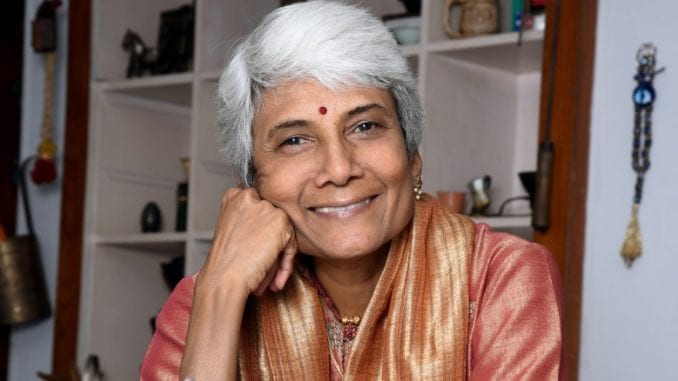
April + May 2017 Anniversary Issue Master Q+A Continued: Sunalini Menon
BY KENNETH R. OLSON
BARISTA MAGAZINE
We had the opportunity to interview Sunalini Menon for the April+May 2017 Anniversary Issue. In a fascinating discussion of her personal history in coffee, Sunalini shared more than we were able to print in the Master Q+A article. Luckily, we are able to give more space to the conversation here on Barista Magazine Online.
Sunalini has had a long and interesting professional life, and her work as a trail-blazing woman in India gives her some unique insight and a special perspective—not only on the evolution of specialty coffee, but also the changes and growth of coffee retailing in India.
Read on to see what else this amazing woman has to share:
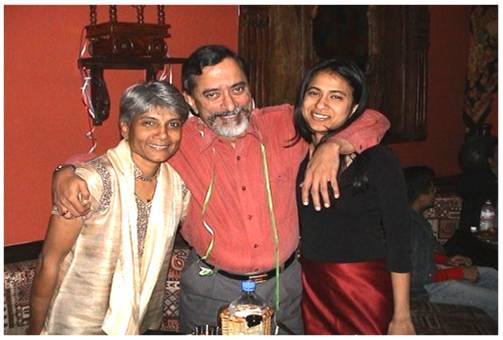
BMag: India is famously a tea-producing and tea-drinking culture. How have you witnessed the coffee industry grow and develop in India? What do you think the future holds?
Sunalini Menon: India is a tea-producing country, and the tea-drinking culture is firmly entrenched in our ethos. Our coffee drinking commenced mainly as a Southern drink, since coffee is grown in the south of India, and most South Indians learnt and enjoyed preparing a cup of coffee on the Indian filter. This art of brewing on the traditional filter has been passed on from one generation to another.
In the north, east, and west of India, and in many regions of South India, tea was mainly drunk, as the shelf life of tea is much longer than coffee. It is easy to prepare, readily available at every nook and corner of India, and most importantly, tea is much less expensive than coffee. Added, coffee was not only expensive, but it had a short shelf life, considering the poor packing for roasted and ground coffees at that point of time, and was considered cumbersome to prepare. It was much easier to toss a couple of tea leaves into hot water to make a cup of tea!
In India, coffee consumption commenced its upward journey from 1995, when the coffee market in India was liberalized and the coffee farmers were allowed to market their coffee on their own, either in the domestic market or in the export market, without having to deliver their entire produce to the Coffee Board of India for purposes of marketing. It was at this juncture that computers made a foray into the country and one of the leading coffee-growing companies in India, which had 120 years of experience in growing and trading in coffee—M/s. Amalgamated Bean Coffee Trading Company—ventured into setting up the first coffee cafe in Bangalore, which is considered the capital for coffee in India. This coffee company set up Café Coffee Day in a busy thoroughfare in Bangalore, cashing in on the entry of computers into the country. Their vision was “Youth, Energy and Friendship,” and the tagline was: “A lot can happen over a cup of coffee.”
For an hour of surfing on the net, a free cup of coffee was served to the customer. Young people flocked to the cafe, as they wanted to surf the net and to also hang out with their friends in a warm and comfortable ambience. Thus commenced the cafe culture in India.
Coffee was no longer considered a drink to be drunk at home, a drink which was dull and boring and meant for the elderly. It started being looked at as a youthful drink and as a hip-hop and happening beverage, to be shared with friends or while surfing the net.
In India, the future for coffee is bright and optimistic. We now have a large number of cafes not only in urban India, but also in rural India. We have IT specialists, who have returned from the U.S., now venturing into the setting up of small cafes, bringing in their overseas experience of coffee and turning them into a reality in their own cafes in the country.
Online marketing of coffee, roasting of coffee in a cafe, conducting educational sessions for the consumers in the cafe, pairing and serving food with coffee, and marketing of roasted and ground coffee in special packs as a single-estate brand are the changes that are taking place in India, besides the trend of serving coffee in a variety of ways such as the pourover, AeroPress, French Press, Siphon, etc.—apart from the espresso and cappuccino.
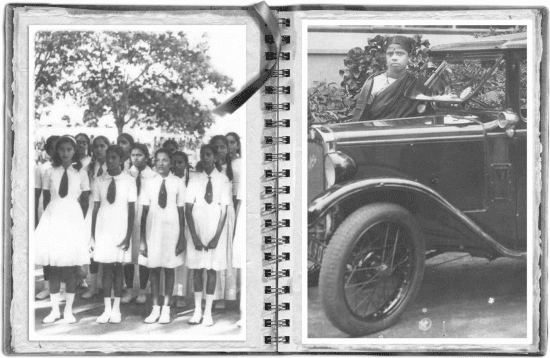
BMag: Can you tell us about the evolution of coffee culture in India from the consumer side, and what you have witnessed on the production side that has changed? What do you think the future is for both?
Sunalini: Coffee culture in India has evolved from being just a wayside drink in Southern India, drunk on the roadside in small coffee parlors, to coffee being consumed in small outlets called ‘Darshinis,’ which had better ambience than the wayside parlors, to the present scenario of coffee being drunk in cafes. The cafes sport a hep and bright ambience, with better-quality coffees being served, with a range of coffee drinks and food to go along with these coffee drinks.
Today, with the rise of double-income families, the woman of the family venturing out, the economic status of the family rising, and with people traveling outside India and wanting to experience their overseas experiences in India, the coffee scenario has witnessed tremendous growth.
At present, we have coffee cafes located in urban and rural India, with trendy ambience and many varieties of coffee drinks. The chicory culture, which was a part of the Indian filter-coffee-drinking habit in Southern India, has declined, when compared to the past. This has occurred due to the espressos and cappuccinos being served in the cafes, where there is very little filter coffee being served.
On the coffee production front, we have risen from a figure of 35,000 tonnes in 1970, to 1,45,000 tonnes in 1985, to 1,80,000 tonnes in 1995, to 2,50,000 tonnes in 2001, to the present day figure of 3,30,000 tonnes. Production has increased, with the area under coffee increasing only marginally.
In India, we grow both the species of coffee, which has helped the roasters in their blending exercise to create blends that suit the palate of consumers in the different regions in India. The productivity of coffee is improving and the consumption of coffee has increased from a low figure of 55,000 tonnes in the 1980s to around 1,20,000 tonnes as of today. While the figures may not seem high or interesting, the point to note is that coffee is much more expensive than tea, which is easy to make, besides having a longer shelf life.
In India, coffee is served with milk and sugar, and this is where education is being focused, to educate the consumer on the aromatic and flavor nuances of the coffee cup and how they can be identified and appreciated when coffee is drunk black.
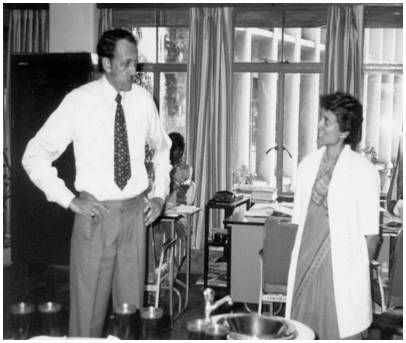
BMag: India is known for producing both robusta and Arabica coffees. Do you feel both varieties play an important role for farmers? How have Indian farmers been working to improve quality for each?
Sunalini: Coffee was introduced into India in 1870 from the Middle East. The story goes that a saint by the name of Bababudan brought into India seven coffee seeds on his return from a pilgrimage to Mecca. He is said to have planted these seeds on the Bababudan range of mountains, from where coffee cultivation spread to other regions in India.
Arabica coffee was the first species to be planted in the southern state of Karnataka. However, as this species was ravaged by leaf rust by the end of the 18th century, robusta was introduced at the beginning of the 19th century in the state of Kerala.
Today, we have both species of coffee growing side by side, with the quantum of robusta being larger than Arabica, as the Arabica species is being ravaged by pests and diseases, with climate change not helping its production. However, steps are being taken to improve both the quality and quantity of Arabica coffee in India, to ensure that there is an even keel of both Arabica and robusta being produced.
Both the species or varieties play a very important role in the livelihood of our farmers. While the famers are well aware that Arabica is a flavorful coffee, they have carried out impressive work in the processing of robusta coffees, whose cost of production is less than that of Arabica. Both Arabicas and robustas are treated on par with each other at the time of cultivation and at the time of processing, resulting in some spectacular robusta coffees being produced in India. While farmers realize that the cost of production of robusta is less than that of Arabica, they are also aware of the fact that in the world market, they would get a better price for Arabica coffee when compared to robusta. However, with microlots of coffee gathering momentum in the world market, farmers in India have started working on preparing microlots of unique and distinctive coffees, not only with the Arabica species, but also with the robusta species, helping the buyer to realize and understand that tasty and flavorful robustas too can be produced and can be utilized not only in a blend, but also as a standalone.
Indian farmers are world-class in their cultural practices for coffee. They are very knowledgeable on how to grow coffee. It is only in the recent past that the farmers have realized that they would now have to work on their processing techniques if they wanted to move up the ladder, from being just a filler coffee to being a coffee with distinctiveness in the cup. Farmers have been working on this aspect, experimenting with different ways of processing their washed, unwashed, and honey sun-dried coffees. Every farmer is looking to see how they can better the quality in the cup, as they now understand that ultimately a buyer would be willing to pay more, not for quantity, but for quality.
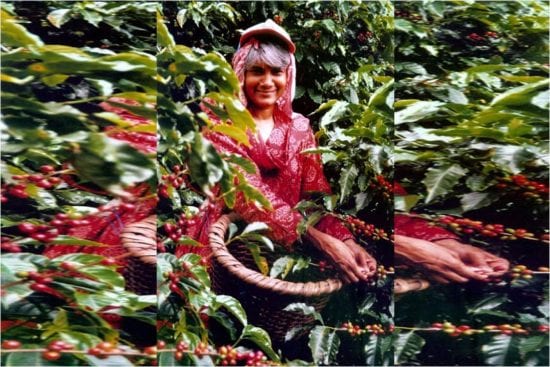
BMag: What do you think are the biggest challenges facing coffee cultivation and coffee farmers in the future globally and locally? Do you think there are opportunities as well? If so, are there other regions in India that may start or increase coffee cultivation?
Sunalini: The biggest challenges facing coffee cultivation and coffee farmers globally and locally are climate change, lack of labor to carry out the various operations connected with coffee, escalation in the cost of production, and the continuous change in the taste requirements of consumers, necessitating the farmers to also change the manner in which they need to handle and process the coffees produced on their farm.
Today, with climate change, the farmers are facing challenges in the quantity and quality of coffee being produced, with new pests and diseases rearing their head. The change in the cup quality of their produce due to unexpected drought, due to heavy rainfall, or due to high temperatures have been challenging.
Availability of labor is also diminishing, with the young generation of coffee families wanting to better their lives by moving away from coffee-growing regions to the city, to secure better jobs and to better their status.
The escalation in cost of production has occurred due to rising cost of fertilizers, the lack of water for processing, the increase in cost of equipment, and the high cost of labor to carry out the various tasks on the farm.
There are opportunities in coffee too. The biggest opportunity is the increase in coffee consumption in the world market. Coffee consumption is said to be increasing every year, with the annual consumption rising at a rate of 2.5 to 3 percent. This is the biggest opportunity in that people, especially the Millennials, are wanting to drink more coffee—not only to just drink coffee, but to drink coffee prepared on different equipment, to highlight different flavor notes in their cup of coffee. The consumer is becoming adventurous and at the same time wants traceability and quality in the coffee cup—and is willing to pay for this experience. This is certainly an opportunity for all coffee-producing countries, though the prediction is that climate change could bring about extinction of coffee in the next 50 to 80 years.
In India, we are trying to increase the productivity of our existing coffee-growing regions, and are only marginally opening up certain coffee growing areas in the north of India.
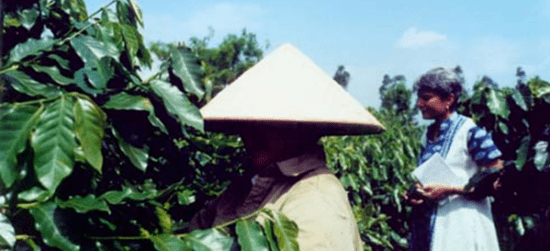
BMag: Do you think your perspective as a woman has given you any particular insight into coffee and the coffee business, or helped your male colleagues consider an alternative viewpoint than they might have? Have you been able to work directly with women coffee producers? Can you tell us what those experiences are like?
As women, I think, we are more careful and conscientious in executing any item of work that is given to us. We are god-fearing, pay a great deal of attention to detail, and we will never give up until the work is completed, even if the working hours have been completed for the day. Our motto is never to say: ‘I will complete the task tomorrow.’ I think these perspectives in women have helped in ensuring that a great deal of attention and passion are put into the task at hand.
My perspective as a woman has given me the insight to look at coffee as a living bean, which emotes in a manner similar to a human being. This insight I developed when I was training on the field and at the coffee processing factory, during the early days of my career at the Board. I found that when I had dropped a few beans of coffee inadvertently into a pot of compost while evaluating a sample of green coffee in the field, coffee plants had sprung up a week later, much to my astonishment. It was then that I realized that the bean was a living bean and could germinate into a plant. A second instance was when I was auditing the store house of a dry milling factory. I found that the store house was hot and humid, and I was perspiring profusely. When I started checking the quality of coffee in the jute bags in the store house, I found many white beans in the coffee lot, and I came to understand that these were defective beans caused by high temperature and humidity. Learning from these experiences, I have been able to convince, especially my male colleagues and coffee farmers, that the coffee bean is not only a living bean, but has emotions similar to each one of us. When we are feeling hot and sweaty, the beans too feel the same, and today, my male friends understand and are convinced of this alternative view that coffee is humane too!
Yes, I have been able to work with women coffee producers. The first woman’s coffee was launched by a woman coffee producer, whose coffee was being processed under my guidance for the past few coffee seasons. She knew nothing about coffee to start with, but was ever ready to follow instructions and to carry them out meticulously, implicitly, and with care. We were able to launch her product in the very quality-conscious market of Japan. What I learnt from the woman coffee producer was her strength to achieve, her perseverance, and her willingness to face challenges and to implicitly trust and be guided in her quest to brand her produce.
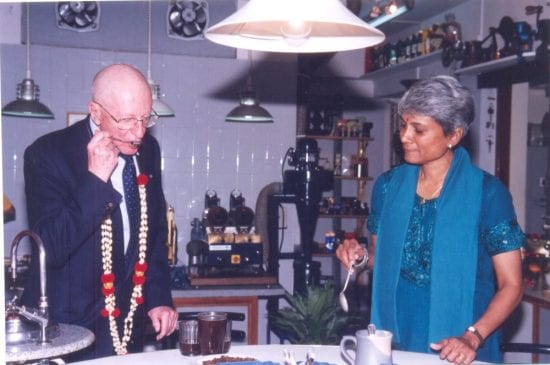
BMag: Why have you devoted so much of your life to working in coffee? Is there something unique about coffee that draws you to it?
Coffee has something very unique that prevents me from walking away from it. It is not just the aroma or taste that stimulates me. It is the tiny green coffee bean, which has taught me that it is a living bean, which has educated me on its taste profile based on its treatment at the farm and which has challenged my mind power, the strength of my hands, and the passion of my heart. It has humbled me on its journey into the coffee cup!
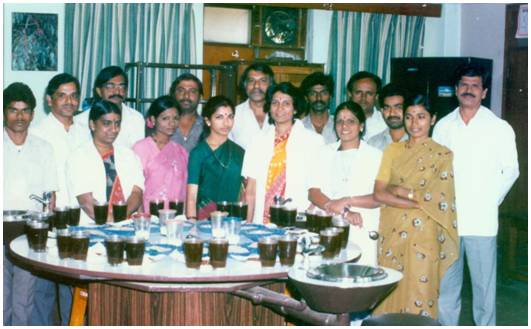
BMag: Finally, do you have any advice for someone starting a career in coffee today?
A career in coffee is fascinating, stimulating, and creative. It is a career, which needs acuity of taste, which needs dedication, which needs hard work, which needs concentration, and which needs good memory and communication skills to communicate effectively what you have experienced in the palate.
It is a great career to be in, as it unfolds and opens up vistas, which have not been visited before, exciting and sharpening your senses, making you more curious and inquisitive on the subtle nuances of the cup. At the same time, it humbles you to understand that the lives of so many coffee farmers are dependent on that tiny bean and that cup of coffee that you are evaluating. The coffee cup is a harbinger of memories, conversations, and laughter. I, for one, have enjoyed and continue to enjoy my career in coffee, and I would strongly recommend others to look at the coffee bean not just as a tiny green bean, but as a bean which can mold you, which can teach you, which can humble you, and which can aromatize and stimulate you and those around you! Remember, coffee can become your bread and butter, but you need to work with the courage of your mind, the strength of your hands, and the passion of your heart to realize this dream of bread, butter, and coffee!!

